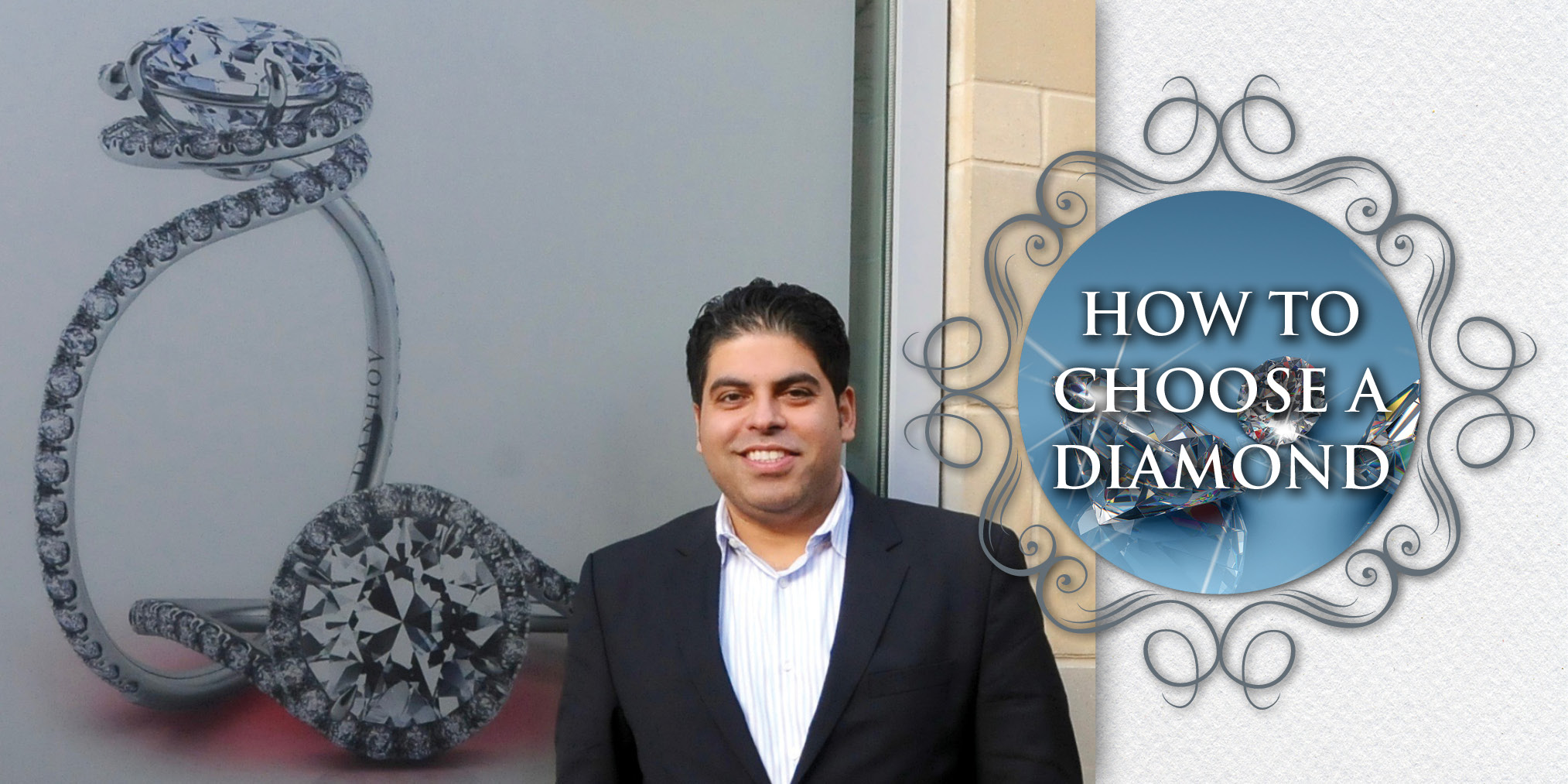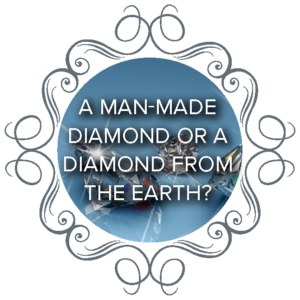Diamonds have always been a symbol of elegance and class. But for lovers, it’s the symbol of eternal love and commitment. They are essential in any engagement ring and we see them often in wedding bands for both men and women.
How to choose the size, the cut, the color, or the quality of the diamond takes a lot of research because in the end, a diamond is an investment. But how do you know you are buying a good quality diamond? How do you know the expensive rock you’re investing in today, won’t be worthless in a few years? Bobby Singh, owner of Midtown Jewelers at the Reston Town Center, talked with us to give our readers the best advice when choosing their diamonds.
It is common knowledge that a diamond is a very rare and unique substance that comes from the ground, but to the surprise of many people there exist what is called the “HTP diamond,” which is a man-made stone that is very new to the market. Bobby advises, however, to only buy a GIA (Gemological Institute of America) certified diamond. “GIA is the national institution for grading diamonds, and is a worldwide institution, it is the strictest and sought after institution.” Says Bobby. “When you are buying a GIA diamond, you know what you are buying is something that will be accurate in terms of the color, the size, the clarity, everything on it. You will know it is a real diamond, that it is not heat treated, so that it is not a handmade diamond, but a diamond that came from the earth.”
GIA Diamonds come with a GIA certificate and are laser inscribed, which means that even though diamonds are a really small piece of rock, on the side of the diamond, they have a little inscription of GIA with the identification number.
Although HTP diamonds may look just like a real diamond, the risk of buying one of them is their value. “The pricing of the HTP diamonds compared to a real diamond that is being mined from the earth is very similar; there’s not much difference yet,” he says. “But at the end of the day, a person can buy a diamond that is $5,000, and a year from now, that same diamond, since it is manmade, may only be worth $1,000,” explains Bobby. “A real diamond is not lab grown or grown in a factory. Mother Nature has taken hundreds and thousands and millions of years to cultivate to make this shiny piece of brilliance,” he says.
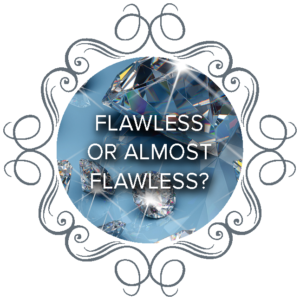 Diamonds rank in different types of clarity, being “FL” completely Flawless, and going down to “IF”-Internal Flawless where external flaws can be removed; VVS1-VVS2, which don’t have any internal black marks; VS1-VS2, where flaws are barely visible with a microscope; S11-S12, in which flaws are easily visible with a microscope, and 11-12-13, in which flaws can be found with the naked eye.
Diamonds rank in different types of clarity, being “FL” completely Flawless, and going down to “IF”-Internal Flawless where external flaws can be removed; VVS1-VVS2, which don’t have any internal black marks; VS1-VS2, where flaws are barely visible with a microscope; S11-S12, in which flaws are easily visible with a microscope, and 11-12-13, in which flaws can be found with the naked eye.
“The average person, me included, as a jeweler who has been looking at diamonds for years and years, I can’t tell the difference between an Internally Flawless, or a VVS diamond, compared to a VS diamond,” Bobby explains.
In terms of color, diamonds are categorized as D-F or colorless; G-J, near colorless; K-M slightly tinted; N-R very light yellow; and S-Z-light yellow or brown.
“There is a big difference between a diamond that would be a lighter yellow color say a L, M, or N diamond, versus something that is going to be an I diamond, because that is when the customer can see the imperfections and they can see the color with the naked eye. As a standard from an independent jeweler, if you can’t see it with the naked eye, that means it is a clean diamond.”
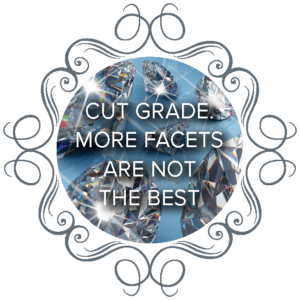 Several years ago both GIA and AGS (American Gem Society) started doing a cut grade. Cut refers not to a diamond’s shape (round, oval, pear, etc.) but to a diamond’s proportions, polish, symmetry and how well a diamond’s facets interact with light. The AGS scale grades a diamond with the four Cs: Cut grade is first, then diamond Color, then Clarity and then Carat weight.
Several years ago both GIA and AGS (American Gem Society) started doing a cut grade. Cut refers not to a diamond’s shape (round, oval, pear, etc.) but to a diamond’s proportions, polish, symmetry and how well a diamond’s facets interact with light. The AGS scale grades a diamond with the four Cs: Cut grade is first, then diamond Color, then Clarity and then Carat weight.
“A traditional diamond is what they call a regular, modern, brilliant cut that will have 58 facets,” explains Bobby. “There are diamonds that are being cut with more facets, so what they’re doing is they are taking a diamond that may not be as pretty, and cutting more facets [to] give it more brilliance.” He advices that some diamonds might be sold with more cuts to make them shinier but the quality is not as good as a GIA certified diamond. “What usually happens is in order to make them have these extra facets, they actually cut the diamond smaller, so you’re losing space on the diamond.”
Bobby explained that the Cut grading only applies to the round brilliant diamond.
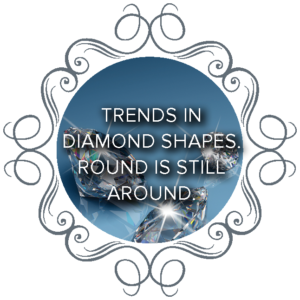 “The round diamond is always the most traditional, the most classic, and the most brilliant,” he said and added that 80-85% of the diamonds being sold in the D.C. market are round, and nationwide it’s closer to 70%.
“The round diamond is always the most traditional, the most classic, and the most brilliant,” he said and added that 80-85% of the diamonds being sold in the D.C. market are round, and nationwide it’s closer to 70%.
“In terms of our store in the Reston area the round diamond is the most popular. The last couple of years, the ‘Halo’ has been a very popular style. ‘Halo’ is when you have the single diamond and then diamonds around it.” He also said the “Princess cut,” goes in and out of popularity and is usually the second most popular cut of diamond. “This year we have a lot of people asking for ovals, a lot of people asking for pear shapes. The princess is still popular,” he said.
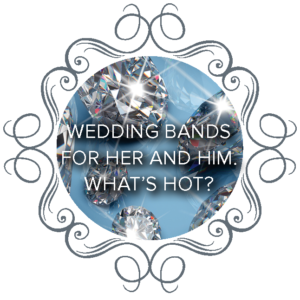 “These days we’re seeing that a lot of women doing multiple wedding bands, meaning that they do one traditional on the backside, then the engagement ring, then a second band on the other side,” he says. It makes the whole ring more symmetrical by placing the engagement ring in the middle, and two bands on the sides. The second band is also an opportunity to make it more creative. “We see a lot of women doing rose gold or yellow gold, so they might do a white gold ring, but have two rose gold or yellow gold bands,” he explains. “We’re seeing a lot of uniqueness because we see a lot of people making their ring more unique in terms of the package to make them more different than everyone else.”
“These days we’re seeing that a lot of women doing multiple wedding bands, meaning that they do one traditional on the backside, then the engagement ring, then a second band on the other side,” he says. It makes the whole ring more symmetrical by placing the engagement ring in the middle, and two bands on the sides. The second band is also an opportunity to make it more creative. “We see a lot of women doing rose gold or yellow gold, so they might do a white gold ring, but have two rose gold or yellow gold bands,” he explains. “We’re seeing a lot of uniqueness because we see a lot of people making their ring more unique in terms of the package to make them more different than everyone else.”
Men are also getting much more creative in terms of their wedding bands. “Guys are pretty basic, a lot of times they are pretty boring, but we’re trying to make them less boring and give them more options,” says Bobby. At his store he has two designers that create unique and personalized wedding bands. “They do really cool things, like meteorite bands, with actual meteorite from the Gibson Meteorite that fell to the earth, and they incorporate it into the band. They mix the metals together and they can put black zirconium, meteorite, and gold together. They can do Damascus steel, which is a process of forged steel where they put layers and layers of steel on top of one another. It is the same type of process that they used to make swords out of in medieval times. They have a unique acid based finish to them that looks very cool.”
In metals Bobby said platinum and gold are still popular with rose gold being the trend right now. “The yellow gold has still not really come back the way that everybody thinks, but it will,” he said. Platinum is one of the most pure white metals, but at the same time 18k gold is also a nice white metal and it has a harder luster to it, meaning that over time, it will wear down and turn a little yellow, but that be easily fixed by polishing it. “Platinum is a very dense metal, and it develops what we call in the industry a patina, so every time it touches something, it develops more of a grey look to it,” said Bobby. “It can be polished, but since platinum is so dense, it just continues to happen. I always try and explain to my customers, if you’re okay with that get platinum, but if that’s going to bother you, 18k do [white gold].”
 Bobby grew up in the diamond and jewelry industry, helping at his father’s jewelry store during his high school and college years. However, the industry is always changing and the way to know what the trends are is observing what the costumers want. “I worked with my dad and I learned a lot there, but the industry is always changing,” he said. “You have to keep focusing on what the customers are liking, what the trends are in terms of what Hollywood stars are wearing. Trends can be much different here on the east coast compared to Chicago in the Midwest or California. What is in California takes 6 months to a year to get over here or maybe what’s in New York is coming down to the DC area. But the best barometer for us when measuring what the customers want, is the customers, because they are coming into our store and they look in the magazine and online and they show us what they want so that is the most helpful.”
Bobby grew up in the diamond and jewelry industry, helping at his father’s jewelry store during his high school and college years. However, the industry is always changing and the way to know what the trends are is observing what the costumers want. “I worked with my dad and I learned a lot there, but the industry is always changing,” he said. “You have to keep focusing on what the customers are liking, what the trends are in terms of what Hollywood stars are wearing. Trends can be much different here on the east coast compared to Chicago in the Midwest or California. What is in California takes 6 months to a year to get over here or maybe what’s in New York is coming down to the DC area. But the best barometer for us when measuring what the customers want, is the customers, because they are coming into our store and they look in the magazine and online and they show us what they want so that is the most helpful.”

